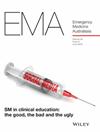Emergency Department Presentations Are Increasing in Acuity in the State of Victoria, Australia—Statewide Hierarchical Regression Model for 2018–2024
Abstract
Background
Emergency departments are seeing an ever-increasing number of patients each year due to various gaps in health services. The aim is to measure significant trends in patient numbers and acuity, considering statewide investment in diversion strategies.
Methods
A multilevel analysis to test for trend over time in emergency department presentations to public hospital emergency departments from 1st July 2018 to 31st June 2024, taking into account clustering of observations by triage category and by health service, and correcting for population growth. Data were extracted from the Australian Institute of Health and Welfare and Australian Bureau of Statistics.
Results
A total of 11,090,840 emergency presentations were reported by 31 health services. Compound annual growth rate calculation noted a rise in category one (8.6%), two (6.8%) and three (2.9%) presentations, and a corresponding reduction in category four (−3.1%) and five (−5.3%) presentations per year over the five-year period. Total presentations increased by 0.7%, while the state population increased by 1.2% per year over the same period. Multilevel modelling correcting for population growth noted a decrease in category four presentations (−2.4%, 95% CI −3.9, −1.0, p < 0.001) and an increase in category three (4.0%, 95% CI 2.4, 5.6, p < 0.001) and category two (10.2%, 95% CI 4.9, 15.5, p < 0.001) presentations. There was no statistically significant growth in overall numbers (1.4%, 95% CI −3.2, 6, p = 0.552).
Conclusion
Emergency department presentations appear to be increasing in acuity in the state of Victoria, Australia. This rising urgency should prompt the health system to anticipate and prepare accordingly.


 求助内容:
求助内容: 应助结果提醒方式:
应助结果提醒方式:


